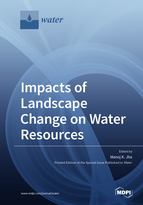Impacts of Landscape Change on Water Resources
A special issue of Water (ISSN 2073-4441). This special issue belongs to the section "Hydrology".
Deadline for manuscript submissions: closed (15 January 2020) | Viewed by 43978
Special Issue Editor
Interests: water cycle; field and watershed modeling; water resource engineering and management; climate change and land-use change impacts on hydrology and water resources; evaluation of BMPs for sediment and nutrients; extreme hydrological events (floods and droughts); uncertainties in modeling and assessment
Special Issues, Collections and Topics in MDPI journals
Special Issue Information
Dear Colleagues,
In order to manage our valuable water resources, it is imperative to understand the degree of vulnerabilities and resiliency to changes in landscape. Continuous changes in land use and land cover can have many drivers, including population growth, urbanization, demand for food, evolution of socio-economic structure, policy regulations, and climate variability. Potential impacts due to these changes could range from changes in water availability (due to changes in losses of water to evapotranspiration and recharge) to degradation in water quality (increased erosion, salinity, chemical loadings, and pathogens). Fields studies are conducted to understand this complexity at local scales, while analyses at regional or watershed scales adopt modeling and simulation strategies. A range of tools, including hydrological, biophysical, ecosystem models are used (stand alone or in combination) to investigate important questions regarding impacts in order to inform the decision making process. These decision analysis tools identify landscape-change impacts, risks, and uncertainties to provide guidance to make key management decisions. In this Special Issue, we will include research and discussion topics from field investigations, as well as analytical and modeling studies to better understand the connection between landscape change and water resources at various scales.
Prof. Dr. Manoj K. Jha
Guest Editor
Manuscript Submission Information
Manuscripts should be submitted online at www.mdpi.com by registering and logging in to this website. Once you are registered, click here to go to the submission form. Manuscripts can be submitted until the deadline. All submissions that pass pre-check are peer-reviewed. Accepted papers will be published continuously in the journal (as soon as accepted) and will be listed together on the special issue website. Research articles, review articles as well as short communications are invited. For planned papers, a title and short abstract (about 100 words) can be sent to the Editorial Office for announcement on this website.
Submitted manuscripts should not have been published previously, nor be under consideration for publication elsewhere (except conference proceedings papers). All manuscripts are thoroughly refereed through a single-blind peer-review process. A guide for authors and other relevant information for submission of manuscripts is available on the Instructions for Authors page. Water is an international peer-reviewed open access semimonthly journal published by MDPI.
Please visit the Instructions for Authors page before submitting a manuscript. The Article Processing Charge (APC) for publication in this open access journal is 2600 CHF (Swiss Francs). Submitted papers should be well formatted and use good English. Authors may use MDPI's English editing service prior to publication or during author revisions.
Keywords
- land use change
- water resources
- water availability
- water quality
- modeling tools
- impact assessment






